Yoko Ono: Fly (1971)
By Madeline Bocaro
https://linktr.ee/conceptualbooks
© Madeline Bocaro, 2019. No part of this site may be reproduced or reblogged in whole or in part in any manner without the permission of the copyright owner.
This is an excerpt from my Yoko Ono biography…

Read all about it, see the reviews and
order here:
Signed hard cover books are exclusively available at:

The double album Fly (released September 1971 in the USA / December in the UK) was the follow-up to Yoko’s debut (Yoko Ono Plastic Ono Band). Parts of Fly were recorded around the same time as John’s album Imagine which was released a few weeks prior. Both albums on Apple Records were recorded at Abbey Road and also at John and Yoko’s home studio at Tittenhurst Park in Ascot (U.K.). Fly was completed at Record Plant (New York) .
The gatefold album’s cover features a distorted double-exposed Polaroid photo of Yoko’s face taken by John Lennon through a glass vase, which makes her look like she is crying. The photo was taken at George Maciunas’ dumpling party at the Fluxhouse Cooperative**. Several goodies came in the album package, including a cool full-sized poster by Raeanne Rubenstein, and a postcard (Yoko’s artwork, A Hole to See the Sky Through) for ordering Yoko’s book Grapefruit. These items are particularly charming in miniature when later released as a CD mini album in Japan.
Just as Yoko inspired John to experiment, Lennon instilled something in Ono that would drastically transform her amorphous music – a beat. Beginning with the seventeen-minute long ‘Mind Train’ and ‘Midsummer New York’, Yoko began writing structured songs with evocative lyrics in a more conventional framework.
“You see, I was doing music of the mind – no sound at all, and everybody sitting around just imagining sounds… But I felt stifled even with that, I was dying to scream, to go back to my voice. And I came to a point where I believed that the idea of avant-garde purity was just as stifling as just doing a rock beat over and over.”
– Yoko to Jonathan Cott – Yoko Ono and Her Sixteen-Track Voice
Rolling Stone March 18, 1971
The rocker ‘Midsummer New York’ was Yoko’s take on Elvis Presley’s ‘Heartbreak Hotel’.
“‘Midsummer New York’ is about the deep insecurity that I have in me that I associate with my life in New York before I met John…I always wanted to make a song that uses the word ‘shaking’ with a double meaning, as I discovered the use of the word in rock in 1968.”
– Yoko Ono *
The prototype for ‘Midsummer New York’ is a very cool unreleased track, ‘Slow Blues’ recorded during the sessions for Yoko’s debut album, Yoko Ono Plastic Ono Band (1970).
A Japan-only bonus track ‘‘Midsummer New York’ appears on Yoko’s 2018 album Warzone!! As I suspected, it is not a re-working of the song, but a 1971 alternate take from the Fly album sessions! It’s also a fantastic vocal, in her own inimitable style – but you can hear her say at the end, “OK, it was barely good.” You can also hear John chattering in the background at the end. I love Yoko’s expletive at the beginning!
Listen here: https://www.youtube.com/watch?v=QU39vjVlx_I
The epic album version of ‘Mind Train’ is a nearly 17-minute long jam, taking us off the rails to places we’ve never been before! Yoko’s train journey predates Kraftwerk’s clanging ‘Trans Europe Express’ by five years. The players are; John Lennon – guitar, Klaus Voormann – bass, Jim Keltner – drums, and Chris Osborne on dobro.
At her Concert for Japan in New York City (March 29, 2011) Yoko introduced the song with an anecdote. “‘Mind Train’ was about 16 minutes long. John insisted on playing it for an unnamed famous musician.” Yoko expressed her regret of having this person endure the whole 16 minutes. Hopefully, it was someone who was well deserving of the wrath of Yoko and wish that it could have been myself instead. After all, one man’s pain is another’s pleasure!
(I later realized that Yoko was referring to the time that she and John played ‘Mind Train’ for Bob Dylan at the Isle of Wight in August 1969. Consider how preposterous and hilarious this is – the prolific poet of rock ‘n’ roll politely listening to something so lyrically abstract and lengthy!! I have much more respect for Dylan now!)
A punk/funk chugging, plodding beat merges with free-form instrumentation and vocals. It was once described as Can doing ‘The Loco-Motion’. (It bears similarity to Can’s 18-minute long track ‘Halleluwah’ on their album Tago Mago, also released in 1971). The reggae rhythm picks up speed toward the end, becoming a total freak-out – especially enthralling when Yoko performs the song live!
Yoko’s somewhat spoken lyrics on ‘Mind Train’ alternate with her trademark wordless utterances. The lyrics are dark at times, repeating, “I thought of killing that man” as if the singer is taking a train ride to alleviate or misdirect anger. The train is conceptual, as Yoko also repeats in a verbal beat, ‘Dub-dub train ploughs through my mind.’ She sings of ‘33 windows shining’…
In numerology, 33 symbolizes the highest spiritual conscious attainable by a human being. In astrology, the sun transitions into a new sign of the zodiac at the 33rd degree. The powerful number 33 is significant in all major religions. In the Bible, Jesus was 33 when he was crucified. Joseph was also 33 when he married the Virgin Mary. Christ in the Gospels accomplishes 33 miracles.
The number 33 has a special meaning in Buddhist religion. It relates to the 33 forms that Kannon can adopt to save humans from danger, and bring prosperity and happiness. In Buddhism, the number 33 connects the familiar world with a higher spiritual realm.
Krishna died at age 33. The Tibetan Book of the Dead has 33 heavens. In Chinese and Japanese Buddhism, the sacred goddess Kuan Yin assumes 33 appearances and undergoes 33 transformations in 33 holy places. She aids souls in reaching nirvana.
In Japan, 33 (“sanjuusan”) is meant to be an unlucky years for women according to Yakudoshi, a set of unlucky ages in Japan.
Yoko’s early artwork Morning Piece consisted of 33 broken pieces of glass for sale.
The number 33 also appears in the lyrics to Yoko’s song ‘Extension 33’ on her 1981 album Season of Glass:
Living at the Y, extension 33…
Living at the Y, 33 years…
Living at the y, in 33 rooms
(Listen to ‘Mind Train’ and some live versions at the bottom of this story – below all the photos).
Where does the Dub-Dub train go?
“Nowhere. And that’s a very beautiful place to go.”
Yoko, Twitter Q&A – March 9, 2012
‘Mind Holes’ is an acoustic blues that blows through the holes in your mind like the wind, clearing out your head.
Although they do not appear on the track, Yoko did write lyrics for Mind Holes:
remember the holes
remember the holes in your mind
search for the holes
search for the holes in your feelings – memories – pain
dream of the holes
dream
‘Don’t Worry Kyoko (Mummys Only Looking For a Hand in the Snow)’:
The opening guitar riff to The Everly Brothers’ ‘Wake Up Little Susie was copped by John and repeated by himself and Eric Clapton throughout Yoko’s song ‘Don’t Worry Kyoko’. This incredible rocking free-form desperate plea from a mother to her young daughter (kidnapped by Yoko’s ex-husband) was called ‘Mum’s Only Looking for Her Hand in the Snow’. It was first recorded at London’s Queen Charlotte’s Hospital with John on acoustic guitar while Yoko was pregnant with John’s child. She later miscarried. The demo was released by Aspen magazine, then on Ryko’s 1997 CD issue of John and Yoko’s Wedding Album.
Yoko mailed the record to Kyoko. It was auctioned via Christies in 2003 by Kyoko’s father, Tony Cox (Sale 9368, Lot 177 Estimate: £8,000-12,000). Description: Acetate of Ono’s song ‘Don’t Worry Kyoko’, recorded (as her handwritten annotation explains) while she was in hospital in late 1968, recovering from a miscarriage. Set to a different Lennon country-blues guitar riff than he played on the finished record, this acoustic rendition was recorded solely for Kyoko’s ears. The record is accompanied by a moving letter from mother to daughter, explaining that she wrote the song to prove she hadn’t forgotten Kyoko during their recent months apart.
This funky blues is always amazing to hear live. It was first performed at the Toronto Rock and Roll Revival festival in September 1969. John introduced the performance; “Now Yoko’s gonna do her thing all over you.” It can be seen in D.A. Pennebaker’s documentary film of the festival, Sweet Toronto. The live audio was mixed at Abbey Road studios and released on the concert album, Live Peace in Toronto. The band included Eric Clapton, Klaus Voormann on bass and drummer Alan White. Yoko’s DWK vocals were John’s inspiration for his raw live performance of, ‘Cold Turkey’.
The studio version of ‘DWK’ was recorded at London’s Lansdown Studios with Lennon on rhythm and Eric Clapton on lead guitar and Ringo on drums. ‘Don’t Worry Kyoko’ was on the b-side of John’s ‘Cold Turkey’. Both sides of the single’s label instruct, ‘PLAY LOUD’.
The fully recorded track is 9:09 – twice as long as the album track. The album version is edited to 4:55. On the unedited tape, Yoko sings for four minutes when she determines that this is the end of the piece, saying “That’s it.” at the 4:10 mark. However, and thankfully the band apparently does not hear her and they continue to play on. Forty seconds later, Yoko says, “OK.” but the musicians are still oblivious. This is where the album track actually begins. Yoko surrenders and begins singing again for the five minutes hat we have come to know and love. On the album, the edit takes place at the start – with Yoko’s newly recorded vocal, screaming the word ‘Snow’ and the sounds of the band fading up.
Listen:
“John is the first person I met who knows how to be free, and that is why he plays such an important role in all of my pieces. For instance, you see that section 3 of Fly is a guitar solo with voice accompaniment rather than the other way around. Most of the pieces in this album are centered around a dialogue between my voice and John’s guitar. John and I crawl, roll and fly together. John brought in musicians that are fine samurais. John, as a rhythm guitarist, leads the rhythm track. He pushes them, drops them, chased them and frees them. He makes it easy for them to fly with me…”
– Yoko Ono, Notes on Fly, written at the St. Regis Hotel, New York City, Fall 1971 for Crawdaddy
A killer live version of DWK is included on John & Yoko’s Sometime in New York City album (1972) on a live jam bonus disc. It was the first live performance of the Plastic Ono Supergroup – Dec. 15th 1969 at the Lyceum, London (my favorite music of ALL TIME). This stunning performance of DWK was allegedly 40 minutes long, edited to 15 minutes on the album.
See my Story: John & Yoko / Plastic Ono Supergroup Live at The Lyceum, London
https://madelinex.com/2003/12/15/plastic-ono-supergroup-the-lyceum-london-1969/
Another wonderful performance of DWK was at the One to One concert at New York City’s Madison Square Garden (August 30, 1972).
In February 2010, Eric Clapton reprised his slide guitar part for the first time in 40 years on DWK (they also performed ‘Yer Blues’!) at Yoko’s 77th birthday concert in the re-formed Plastic Ono Band, with Sean on rhythm guitar. Joining them were Klaus Voormann and Jim Keltner!
My review: We Are Plastic Ono Band – Live in Brooklyn – February 18, 2010
https://madelinex.com/2010/02/18/we-are-plastic-ono-band/
Watch: https://www.youtube.com/watch?v=qzyXHAqiJaM&feature=youtu.b
Introducing DWK at her Bowery Ballroom concert (Sept. 15, 2013) in NYC, Yoko related the story of trying to find her daughter, “I know, I’ll write a song for her and it will be played on the radio, and she will hear it…well, probably my song wasn’t very good.”
However, her song WAS very good! After years of contempt, is now acclaimed as one of Yoko’s best musical pieces. Some of the best cover versions are by the B-52’s, The Tater Totz and Yo La Tengo.
(Yoko and her daughter Kyoko were eventually reunited in the 1994, fourteen years after John’s death.)
Other than these rockers, Fly mostly reflects Yoko’s avant-garde background. The album’s ambience is spectacular with its custom home-made instruments and strange textures. Drum machines and drones were specially made by Fluxus musician Joe Jones (an associate of composers John Cage and LaMonte Young). These atmospheric instruments were used on ‘Don’t Count the Waves’, ‘You’ and ‘Airmale’. Photos of the instruments can be seen in the album’s gatefold.
“I wanted to explore emotions and vibrations which have not been explored as yet in music. I thought of building a house on a hill which makes different sounds by the wind that goes through different windows, doors and holes… ‘Airmale’ is Yang and ‘You’ is Yin. ‘Don’t Count the Waves’ is the water that connects the two Yin and Yang islands. ‘Airmale’ expresses the delicateness of male. ‘You’ expresses the aggressiveness of female. ‘You’ has all the feminine resentment; moaning and satisfaction in it. Finally, there is just a wind blowing over a sand hill over dried white female bones, but still, with emotion. A wind created with tape feedback is what I always wanted to do – a rock number with at tape loop of feedback as a riff. But this will do for now.”
– Yoko Ono, Notes on Fly, written at the St. Regis Hotel, New York City, Fall 1971 for Crawdaddy
Yoko explained:
“The first and second sides are rock songs with a physical beat.
The third and fourth sides are songs to listen to – mind music with a mind beat.”
‘Mrs. Lennon’ is yet another of Yoko Ono’s haunting and eerily prescient songs that somehow induces calm despite its sadness. She began writing the lyrics written in 1969. When the song was released as a single in 1971, Apple Records registered a U.K. phone number and placed newspaper ads with a drawing of a telephone with a fly landed upon it. The text read, “Dial 01- 247 6694 and listen to ‘Mrs. Lennon.’”
John Lennon’s echoing piano, Klaus Voormann’s bass and delicate bells accompanying her somber vocals place Yoko in a ghostly realm as she contemplates her position as John’s wife and the sublimation of her own identity as an artist. The echoing lament of her vocal is chilling. Especially the line, “Half the world is always killed you know.”
“I wrote it in Ascot. Ascot life was strange! It reminded me of Citizen Kane. I’m sitting there and I see this retired colonel who was our gardener, coming from far far away in the distance, in the huge garden, just walking very slowly… and then the maid coming up and saying, ‘The colonel left these flowers for you, Mrs. Lennon.’ ‘Oh, thank you.”’Uh-huh, Mrs. Lennon! It was like that.”
– Yoko, Goldmine, November 7, 1997
In a segment from the Imagine film with ‘Mrs. Lennon’ as the soundtrack, John and Yoko desperately search for each other through the morning mist. Through all the strife and hell that they have gone through so far as a couple (with much more strife to come) she relents, “I guess it must be alright”. The second half of the song predicts their separation. Although we all know this very well, she says, “neither of them ever left each other”.
And our children, o’ our children
Did they have to go to war?
Yes, my love, it’s okay
Half the world is always killed you know
Husband John extended his hand
Extended his hand to his wife
And he finds, and suddenly he finds
That he has no hands
They’ve lost their bodies
They’ve lost their bodies
Yes, they lost their bodies
Neither of them, o’ neither of them
Ever left each other
Yes, my love, it’s okay
Half the world is always dying you know
‘Mrs. Lennon’ also inspired Alex Chilton’s band Big Star to write their song ‘Holocaust’ on which they lift the exact chord sequence and haunting ambiance. The demo is even more beautiful.
Big Star ‘Holocaust’
https://www.youtube.com/watch?v=vsQ977u8Wuk
Big Star ‘Holocaust’ Demo
https://www.youtube.com/watch?v=jM4ySM76HDM
A gorgeous version of ‘Mrs. Lennon’ remixed by Peter Bjorn and John (Yes, I’m a Witch Too, Feb. 2016) highlights Yoko’s stunning vocals.
Listen to a sample here:
https://www.amazon.com/Mrs-Lennon/dp/B01MTSMT6Y
The best gift of all (which first appeared as a bonus track on the Rykodisc 1997 release of Yoko Ono / Plastic Ono Band, and also on the Secretly Canadian/Chimera reissue of YO / POB in 2016) is the previously unreleased 7+ minutes long ‘Open Your Box’ – a wild version of the B-Side of John’s ‘Power to the People single, later included on Fly as ‘Hirake’ (ひらけ) which means ‘opening’ in Japanese. There is an astonishing section on the outtake where Yoko’s voice soars, miraculously multiplying to resemble a distressed flock of angry birds.
Whenever I listen to Yoko, no matter what song it is, I’m thinking, “This is my favorite song!” My friends always say, “Oh is that the one that goes “Akkkk akkkk akkk akkk?!” I honestly must say, “YES!!!” But this version of ‘Open Your Box’ is my all-time favorite!
Here is the long version of ‘Open Your Box’!
https://www.youtube.com/watch?v=mvlREZKvg9M
Upon release in 1969, the song was banned by BBC radio. In the original lyrics (1969), Yoko asks us to:
‘Open Your Box/trousers/skirt/legs/thighs/flies/ears/nose/mouth/cold feet/
Let’s open the cities / let’s open the world’
In a censored single version, an added echo muffled the questionable lyrics. Yoko re-recorded the replacement lyrics in March at Abbey Road Studios. ‘Trousers’, ‘skirt’, ‘legs’, and ‘thighs’ were changed to ‘houses’, ‘church’, ‘lakes’, and ‘eyes’. The song was completely censored in the USA, and a different Yoko song, ‘Touch Me’ appeared on the B-Side of ‘Power to the People’ instead. (There is also a 2001 remix by Orange Factory).
‘Hirake’
The swishing sounds on the censored single version actually sound really cool! It’s also a really nice mix.
The swishing sounds on the censored single version actually sound really cool! It’s also a really nice mix.
‘Open Your Box ‘- censored single version
https://www.youtube.com/watch?v=y8R_FrF_Bk0
Yoko performed the song live on August 30, 1972 at the One to One concert in NYC at the matinee performance only. This is from the rehearsal:
Five (or possibly a few more) rare copies of the single were made for Yoko’s approval on a white label with ‘Greenfield Morning…’ on the B-Side – ‘Made specially for Yoko Ono’.
Toilet Piece’ is simply the sound of a toilet flushing.
‘O Wind (Body is the Scar of Your Mind)’ is a gorgeously mystical exotic piece that takes us traveling to distant lands. Yoko’s wind-like vocals are enhanced by stunning array of percussive sounds including table, claves, cymbals.
The album includes two film soundtracks. ‘Airmale’ was the audio to John Lennon’s film Erection (a reverse homage to Andy Warhol’s film Sleep, which features the close-up face of a man receiving a blow job). Despite its suggestive title, Erection ironically shows a time-lapse of a building being erected. Yoko speaks the Japanese lyrics to ‘Airmale’ quietly and casually, as if talking to an intimate friend, suggestively saying. “Hey, why don’t you play with me?” These same Japanese words, ‘Nee, anta, chotto, asonde Ikanai?’ were previously uttered by Yoko on her first collaboration with John, Unfinished Music No. 1: Two Virgins in 1968.
As much as Yoko repeats the words ‘Don’t Count the Waves’ I can’t help envisioning waves and counting them! Joe Jones’ weird percussive instruments lend an earthy ambient timbre, as Yoko’s voice reverberates and reiterates.
The title track ‘Fly’ (Yoko vocalizing the part of the insect) is the soundtrack of Yoko’s film of the same name (a.k.a. Film No. 13). In the film which portrays submission of the female, a crawling fly uses the body of a naked woman as its landscape as she lies perfectly still. The first attempt was recorded with Yoko’s vocal and John on acoustic guitar at the St. Regis Hotel in NYC in December 1970. It was to be the first track recorded for the album.
Madeline Bocaro: For the soundtrack to your film Fly, how did you get inside the mind of the flies to make the sounds that they would make while crawling on a naked woman’s body? I think you did a great job! Xxx
Yoko: Thank you! What I did in that situation is that I was feeling like I was a fly
– August 2018
The original attempt at ‘Fly’ is a 16:38 piece called ‘The South Wind’ which appeared on Rykodisc’s 1997 release of Yoko Ono / Plastic Ono Band. Yoko vocalizes with John on acoustic guitar.
Also see: Yoko Film No. 13: Fly
By Madeline Bocaro ©
https://madelinex.com/2005/03/09/yoko-film-fly/
On the 2017 Secretly Canadian/Chimera reissue of Fly, ‘Head Play’ medley (‘You / Airmale / Fly’ bonus track) swirls around your head like a cyclone! These wordless vocal pieces communicate much more than any language.
Why does Yoko, who speaks two languages fluently,
choose to completely evade words? BECAUSE THERE ARE NO WORDS!
“I realized that the classics, when they went from 4/4 to 4/3, lost the heartbeat. It’s as if they left the ground and lived on the 40th floor. Schoenberg and Webern – Webern’s on the top of the Empire State Building. But that’s all right. Our conceptual rhythm got complex, but we still have the body and the beat. Conceptual rhythm I carry on with my voice, which has a very complicated rhythm even in ‘Why,’ but the bass and the drum is the heartbeat. So the body and the conceptual rhythms go together. These days I’m putting a beat under everything I do.”
– To Jonathan Cott, Yoko Ono and Her Sixteen-Track Voice,
Rolling Stone March 18, 1971
‘Telephone Piece’ ends Side Four of Fly. A phone rings six times, Yoko answers it and says ‘Hello, this is Yoko’. It is so cool that she voiced it in the language (and particular ringtone) of each country that the Fly album was released in; USA, UK and Japan.
‘Telephone Piece’ (English version) is sampled on Yoko’s song ‘Talking to the Universe’ (Rising, 1995).
Listen to all three versions here.
(In the case of the UK version, the phone ring is different. On the Japanese vinyl, Yoko answers, “Moshi moshi, Yoko desu.”)
‘Telephone Piece’ began as an instruction in Yoko’s book Grapefruit (1964).
ECHO TELEPHONE PIECE
Get a telephone that only echoes back
your voice.
Call every day and talk about many
things.
1964 spring
Telephone Piece later evolved into an interactive museum piece at Yoko’s exhibitions. A telephone sits atop a pedestal in the middle of a Plexiglas maze (actually, her artwork called Amaze) with the instruction:
When the phone rings
Know that it’s me
Y.O.
(For her Dream Come True exhibit in Argentina (2016), the telephone was red, harking back to the 1960s when volatile phone communications between countries were called ‘red phone’.)
Jim Keltner described the way Yoko communicated what she wanted to hear on the album:
“There we were at the Ascot mansion and Yoko was describing to Bobby Keyes the sound that she wanted him to play with his mouthpiece out of his saxophone; which was ‘the sound of the wind rushing over the back of a frog sitting on top of the world.’ I remember thinking, I know exactly what that sound is. I got on with Yoko really well”
– Jim Keltner, imaginejohnyoko, deluxe edition
Singles
‘Midsummer New York’ – 29 September 1971 (USA) and on 29 October 1971 (UK).
The B-side was an edit of ‘Mind Train’
‘Mrs. Lennon’ was released as a single with the B-Side ‘Midsummer New York’.
‘Mind Train’ – January 20, 1972. A four-minute edit of the long album version. The single was also released in a picture sleeve and features the special Yoko/Apple label on the A-Side and the sliced apple on the B-Side.
The B-Side was another solo Ono composition, ‘Listen the Snow is Falling’, which had previously backed the single ‘Happy Xmas (War is Over)’ in America in December 1971.
Also see: Yoko Songs: ‘Listen, the Snow Is Falling’
By Madeline Bocaro ©
* Notes on Fly, written at the St. Regis Hotel, New York City, Fall 1971 – Yoko Ono
** Fluxhouse Cooperative 80 Wooster Street, SoHo, NYC.
FLY
(All songs written by Yoko Ono)
Yoko Ono – vocals, claves on “Airmale” and “Don’t Count the Waves”
John Lennon – guitar, piano on “Mrs. Lennon”, organ, automated music machines on “Airmale” and “Don’t Count the Waves”
Klaus Voormann – guitar, bass guitar, bells on “Mrs. Lennon”, cymbal on “O’Wind”, percussion on “Don’t Count the Waves”
Bobby Keyes – claves on “O’Wind”
Eric Clapton – guitar on “Don’t Worry, Kyoko (Mummy’s Only Looking for Her Hand in the Snow)”
Jim Keltner – drums, tuned drum, tabla, percussion
Ringo Starr – drums on “Don’t Worry, Kyoko (Mummy’s Only Looking for Her Hand in the Snow)”
Jim Gordon – drums on “Hirake”, tabla on “O’Wind”
Chris Osborne – dobro on “Midsummer New York” and “Mind Train”
Joe Jones – automated music machines on “Airmale”, “Don’t Count the Waves” and “You”
George Marino – mastering engineer
Reissues
1998 Reissue bonus tracks:
‘Between the Takes’
‘Will You Touch Me’ (Demo). This was recorded during the Fly sessions in November 1971.
A new version was made for Yoko’s album Season of Glass (1981).
The original is on the Rykodisc reissue of Fly (1998).
2017 Reissue bonus tracks:
Fly was reissued by Secretly Canadian/Chimera Music on Vinyl, CD, and for digital download in July 2017.
‘The Path’
‘Head Play (Medley: You/Airmale/Fly)’
© Madeline Bocaro 2019. No part of this text may be copied, photocopied, reproduced, translated, reblogged or reduced to any electronic medium or machine-readable form, in whole or in part, without prior written consent. Any other reproduction in any form without permission is prohibited. All of the text contained on this site is protected by United States copyright law and may not be reproduced, distributed, transmitted, displayed, published or broadcast without prior written permission from Madeline Bocaro.
This is an excerpt from my book
In Your Mind – The Infinite Universe of Yoko Ono
An all-embracing look at Yoko Ono’s life, music and art – in stunning detail.
Read all about it, see the reviews and
ORDER HERE:
Contact: conceptualbooks@icloud.com
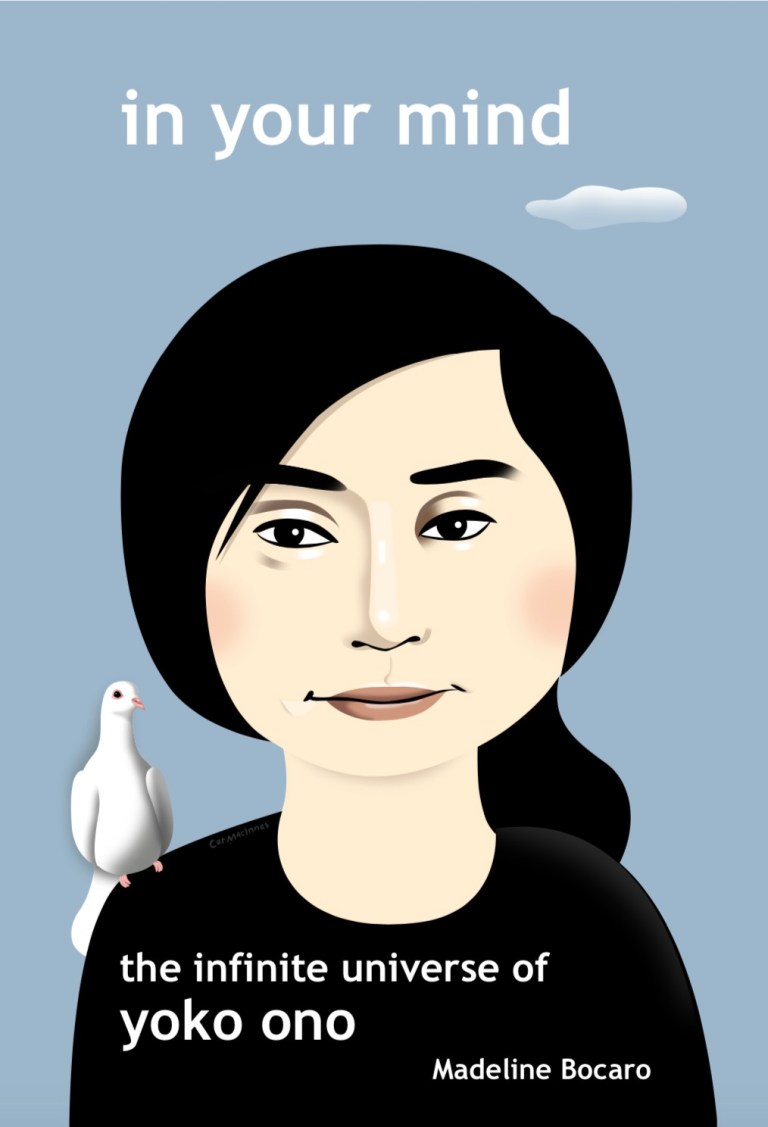
HARD COVER books are ONLY available at…
Conceptual Books
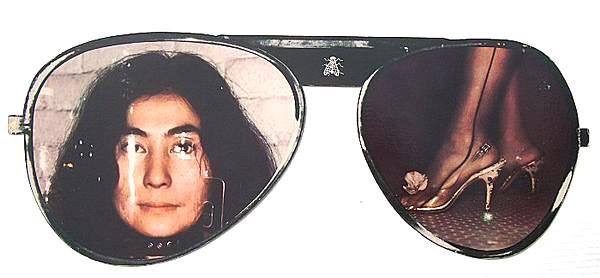
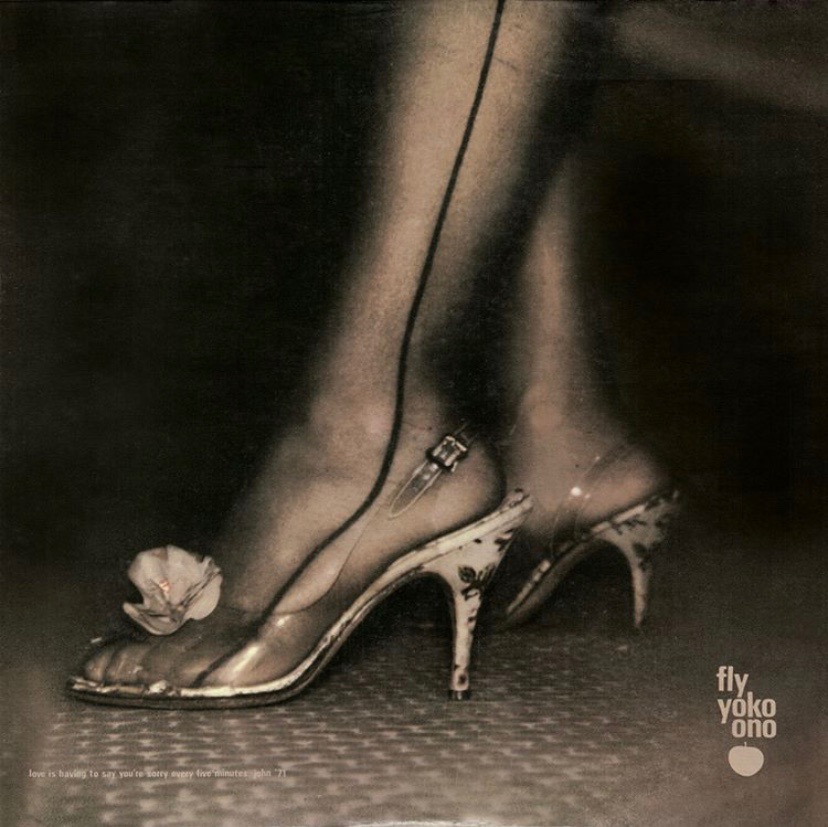





MIND TRAIN:
Listen here…
Album version
A REALLY COOL live version:
Yoko Ono & IMA – ‘Mind Train’ – live Melkweg Amsterdam Holland 25 May 1996
featuring Sean Lennon & Timo Ellis & Sam Koppelman
Live @ Concert For Japan, NYC 2011
Mind Train (Live @ Nakano Sun Plaza) Japan, 1974
(The live @ Meltdown version in 2009 is also amazing!)
Imagine film segment of ‘Mind Train’

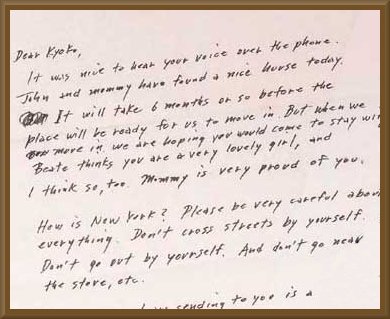










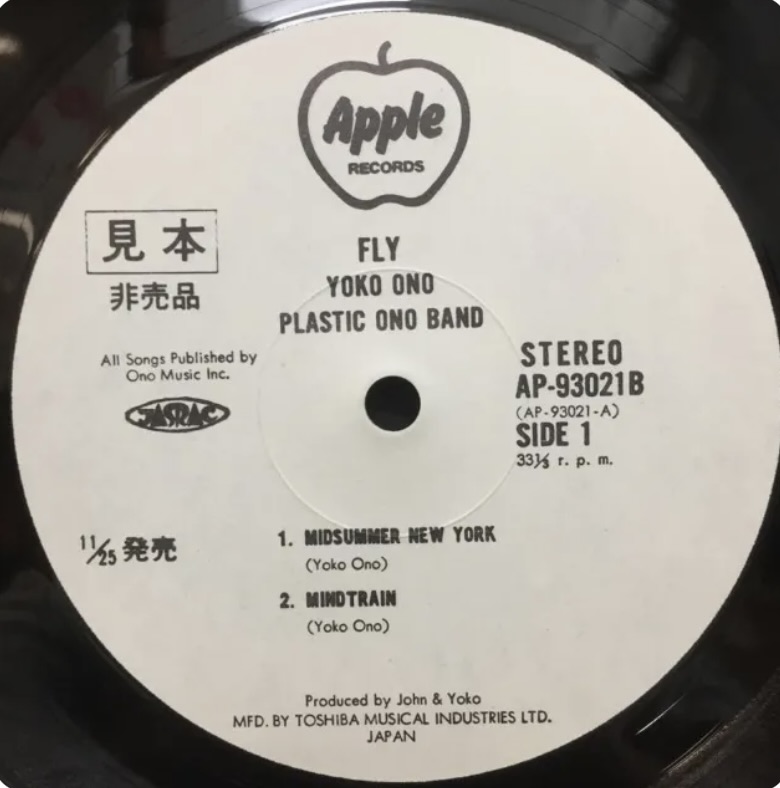


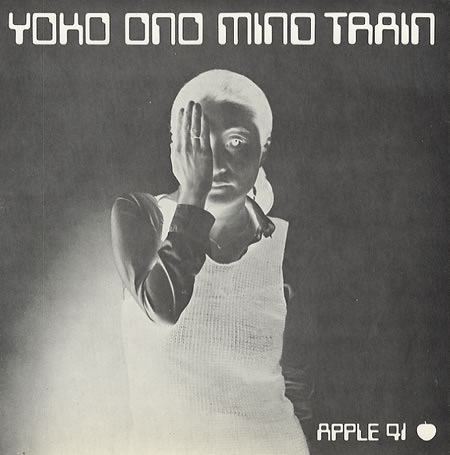


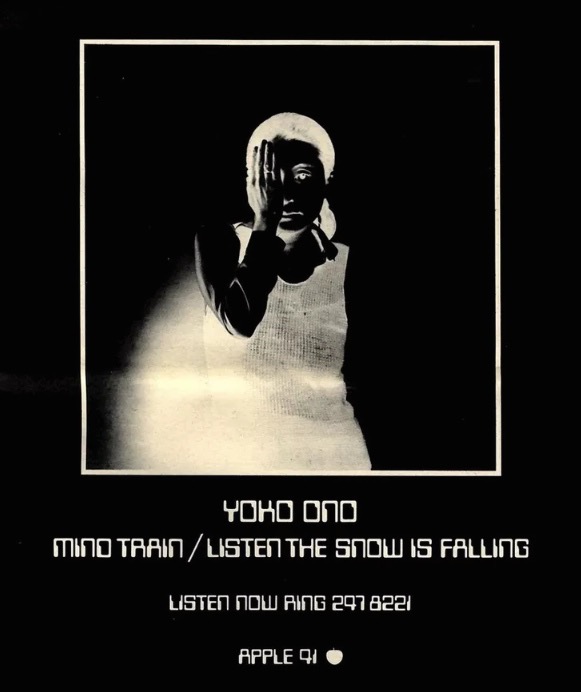






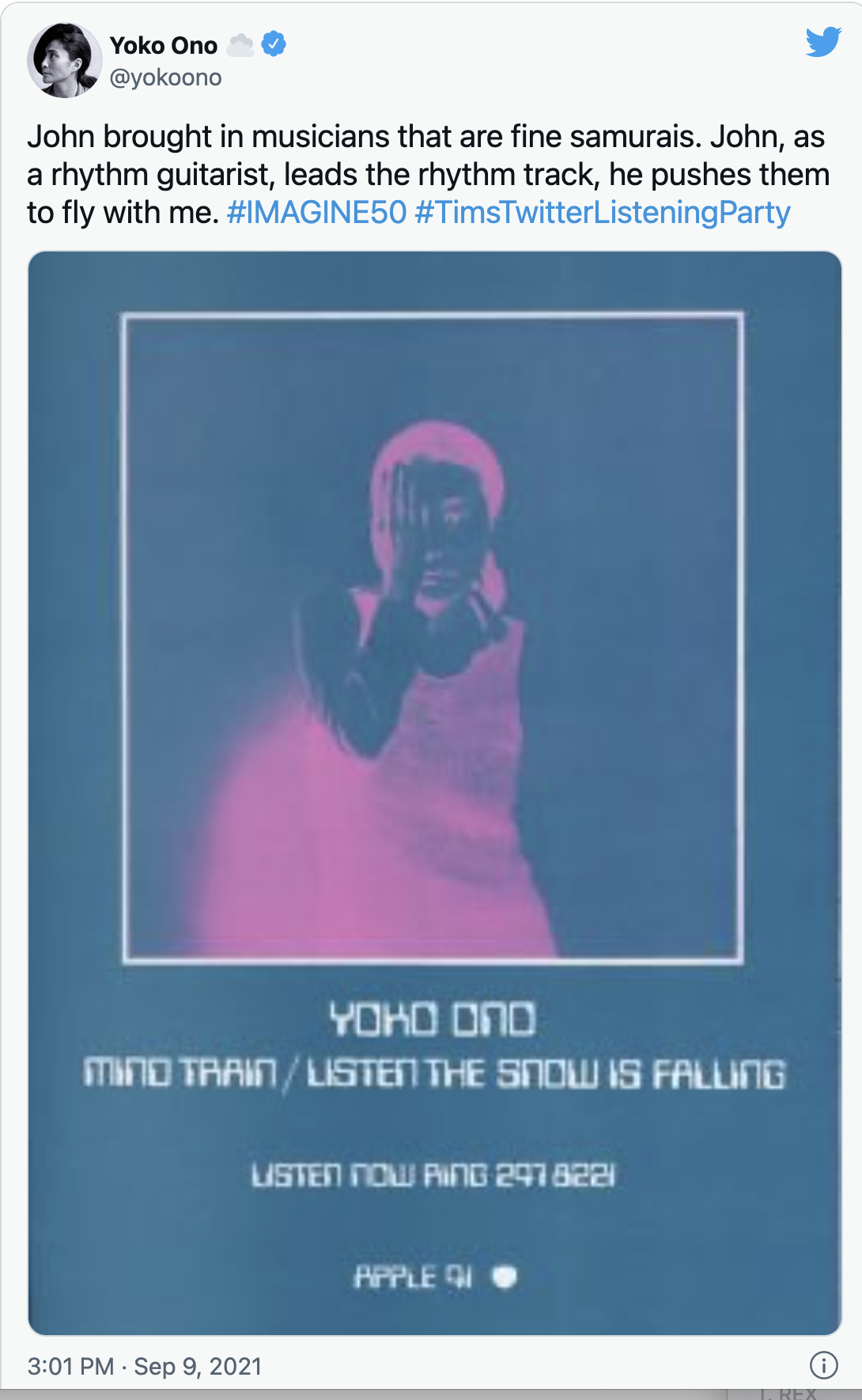



nice article
This is one of my favourite pieces you’ve written so far. I absolutely love this fantastic album. The article is so full of info, it would be wonderful expanded into a full length 33 and a 3rd book. Speaking of which, the section on the numerological significance of 33 is fascinating. That 8 track and single picture sleeves have me drooling as well. All the well known and rightly loved rock classics that came along circa ’71 made it a classic year, but the real action was the likes of this, The Stooges. Incredible. Btw, ‘Sleep’ depicts just that – John Giorno peacefully kipping for six hours, and the tight focus on the face of a fellow elated by fellatio is recorded in a film entitled ‘Blow Job’. I haven’t actually sat through ‘Sleep’, so beg forgiveness if Giorno gets some nocturnal oral-genital contact. Andy’s movies deliver exactly what the title implies – almost, since what is suggested is framed out of shot. Also ‘Erection’ must be a sardonic response to ‘Empire’, the infamous interminable static film of the Empire State Building as day turns to night. No one can keep it up forever, Yoko may be implying. After many years, finally to learn Yoko is looking through a glass on the (beautiful) cover. There was a run of early seventies LPs where the artist is photographed through a weird, transparent, distorting mask – this one, ‘Vintage Violence’ by John Cale and a John Entwistle solo record called (I think) ‘Smash Your Head Against The Wall’ (haven’t heard it yet). Which almost leads into Yoko’s ’50s-Punk ‘I Felt Like Smashing My Face Through A Clear Glass Window’. The more I hear, the more it seems that the Punks were just reiterating things that had been done 5 or 6 years before. Well, I’ve droned on enough. Thanks again for an excellent and stimulating read.
I am so happy that you liked my Fly story. It’s one of my favorite albums of all time. Cool that you thought of the transparent images of John Cale and Entwistle as well. I think you will enjoy my Silver Songs playlist (publishing tomorrow) featuring lots of silvery reflective album covers!! M
P.S. based on your recommendation, my next record purchase has gotta be ‘Sometime NY’ with bonus disc – thanks for the tip – and the excellent links to alternate mixes and so forth.
Enjoy! The album upset so many people when it came out, but in retrospect (although the ‘news’ is dated) it’s really cool! Especially Yoko’s songs!!
I’m an older guy and a first wave Yoko head. I was maybe 14 when Apple launched with some wonderful John and Yoko, as well as George Harrison experimental LPs, most notably Wonderwall Music.
Being 14, an early user of mind altering chemicals ( it was Los Angeles after all) and a budding rock musician, I was wide open to anything The Beatles were releasing.
I adored Wonderwall, never connected to Electronic Sounds, but Lennon introding me to Yoko absolutely changed my musical life.
And if Yoko changed my life, Fly changed my Yoko.
This is the stuff legend us made of, and I can’t believe this record was recorded night in 50 years ago. It’s not ahead, behind, it even if its time, but rather completely outside if time.
While do many aspects were appropriated by so many (self included), there is nothing to compare with Fly. Not even in her own considerable canon.
POB was almost entirely made up of intense and crazed energetic jams, as too her Live Peace appearance, and even your own beloved UN concert, here Yoko made an actual album. From the ground up, Fly is an act of creation with occasional unexpected improvisation, as opposed to improvisation with occasional structure.
After Fly we get her again astounding work with Lennon/Spector with Yoko unintentionally inspiring what felt like half the post 1978 Punk and New Wave Bands, but that’s not Fly, and either is the incredibly lyrical and deep down in her heart felt Approximately Infinite Universe she reinvents,bit refines get direction even further, but that’s not Fly either.
Fly us not only a stand alone LP in the mostly sleepy world if Pop/Rock, it completely stands alone in Yoko’ canon as well.
As an aside, at one time or another I have owned just about every version available of this release. Some falling by the wayside as I moved around through the years. I was real excited when Secret Canadian picked up the reissues, and I own those as well.
When I picked up the vinyl Fly I was real impressed with it’s quality. A truly lovely listen, and if course all the cool packaging replicated. Thing is, like all Yoko’s reissues, there is a certain undefinable to me something lacking.
With that in mind and finally being if retirement age with (luckily) a bit if extra dough and a new turntable and audio system, I popped over to Discogs to price a first edition Fly.
I go for the first editions wherever I can to get as close to the untouched master tape as possible.
Well, Yoko is STILL as unpopular as ever. I was able to scoop up the big three (POB, Fly, Approx.) from three different vendors in literally mint condition, one an import, two still in shrink wrap, all with the original sleeves, inner sleeves, postcards poster, the works, with shipping figure for just about $60.00 total.
I’m now listening to a never before cracked open first edition of Fly.
Now THIS is Fly, which is what inspired me to find your essay.
I’m looking forward to seeing some of your others.
Thanks so much for your kind reply. So happy to find another Fly fanatic! Check out the Above Us Only Sky dvd – the Yoko tracks in the remastered Imagine film disc are INCREDIBLE! I went to the NYC screening and I thought I would DIE when I heard ‘Don’t Count The Waves’ in all its glory!!! I love the Japanese mini Fly CD issue with the tiny poster and tiny hole to see the sky through! And of course the Chimera reissues with the grapefruit labels!
Hi, I was just wondering if you could link to any interviews from the Fly era? I love this album so much but have trouble finding articles about it. This article was amazing btw. Is there anywhere that I can find the full “Notes on Fly” interview? Thanks 🙂
Thanks for your comment. Glad you liked my article. I have not seen the ‘Notes’ interview online.